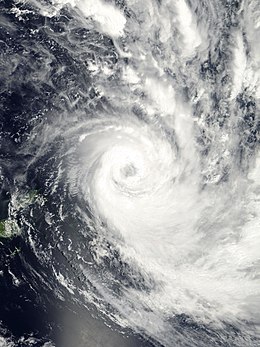Severe Tropical Cyclone Waka
| Category 4 severe tropical cyclone (Aus scale) | |
|---|---|
| Category 3 (Saffir–Simpson scale) | |

Cyclone Waka near peak intensity shortly before moving through Tonga
|
|
| Formed | December 19, 2001 |
| Dissipated | January 2, 2002 |
| Highest winds |
10-minute sustained: 185 km/h (115 mph) 1-minute sustained: 185 km/h (115 mph) Gusts: 250 km/h (155 mph) |
| Lowest pressure | 930 hPa (mbar); 27.46 inHg |
| Fatalities | 1 indirect |
| Damage | $51.4 million (2002 USD) |
| Areas affected | Wallis and Futuna, Niue, Tonga; especially Vava'u, and New Zealand |
| Part of the 2001–02 South Pacific cyclone season | |
Severe Tropical Cyclone Waka (Fiji Meteorological Service designation: 03F, Joint Typhoon Warning Center designation: 07P) was one of the most destructive tropical cyclones ever to affect the South Pacific Kingdom of Tonga. Waka originated within the near-equatorial trough in mid-December 2001, although the system remained disorganized for more than a week. The storm gradually matured and attained tropical cyclone status on December 29. Subsequently, Waka underwent rapid intensification in which it attained its peak intensity as a Category 4 severe tropical cyclone (Australian tropical cyclone intensity scale) on December 31, with winds of 185 km/h (115 mph). Shortly thereafter, it passed directly over Vavaʻu, Tonga, resulting in widespread damage. By January 1, 2002, the cyclone began to weaken as it underwent an extratropical transition. The remnants of Waka persisted for several more days and were last observed near the Southern Ocean on January 6.
In mid-December 2001, at the end of a Madden–Julian oscillation pulse, twin equatorial monsoonal troughs developed in the Northern and Southern Hemispheres. Although warm sea surface temperatures of 30 °C (86 °F) in the region favored development of a tropical cyclone, the southern trough developed substantially slower than the northern one. On December 19, the southern component was classified as Tropical Depression 03F by the Regional Specialized Meteorological Center in Nadi, Fiji (Fiji Meteorological Service); at this time the depression was situated just east of the Solomon Islands. The northern component eventually developed into Typhoon Faxai, an extremely powerful Category 5 equivalent cyclone. Unlike Faxai, the precursor to Cyclone Waka developed slowly, mainly because of moderate wind shear in the region. Moving southeastward, the system gradually became more organized. On two occasions, the Joint Typhoon Warning Center (JTWC) issued a Tropical Cyclone Formation Alert; however, the agency later canceled them both times. By December 27, the depression had entered a region of lesser shear, favoring significant development of the system. The following day, the JTWC classified the system as Tropical Depression 07P, when the storm was situated roughly 640 km (400 mi) northwest of Pago Pago, American Samoa.
...
Wikipedia
